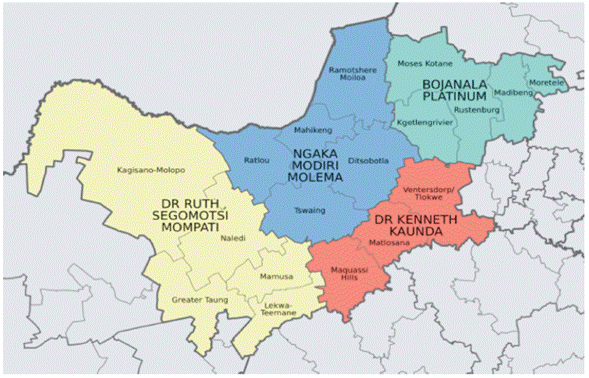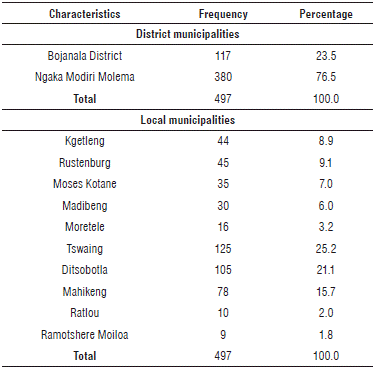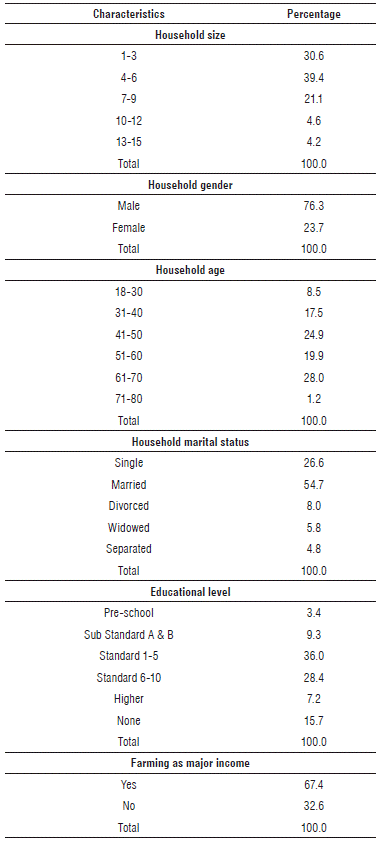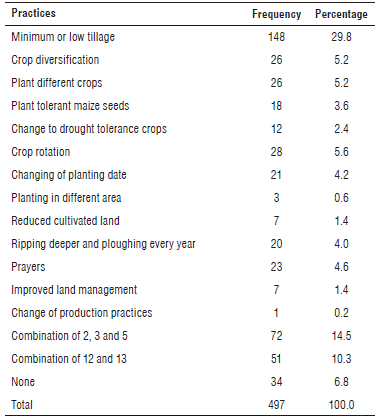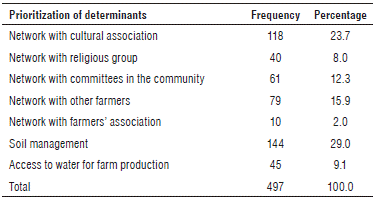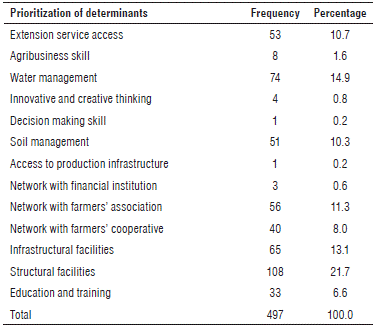Introduction
Global challenges currently experienced in the world today stemmed from global scientific collaborations that rely mainly on the ecosystem. The upshots gave rise to the excessive and formidable environmental problem cited by Udenyi (2010). Climate variability describes the way in which climatic elements such as temperature and rainfall fluctuate over a period. It is a variation around the mean or average that can occur in regular cycles over the years, or more randomly without any specific patterns. In sub-Saharan Africa (SSA), climate variability is the principal cause of changes in food production, South Africa inclusively (IPCC, 2007). In South Africa, climate variability has been responsible for periods of surplus in grain production as well as periods of poor production during which grains have had to be imported. Climate change can affect climate variability by increasing the frequency of extreme climatic events such as extreme temperature, drought, and flood. Climate change is a threat that further exacerbates the already precarious living conditions of many smallholder farmers (Donatti et al., 2018).
Agriculture is highly exposed to climate change, as farming activities directly depend on climatic conditions. It follows that global climate change impact on agricultural production should be considered important (Rosenzweig and Parry, 1994). Several studies reviewed that climate change and variability pose a negative threat to agricultural production and food security. According to Bilham (2011), it was reported that temperature had more impact on the yield of the crop. The impact of climate change is very likely to affect food production at the global, regional, and local level. In every society, agriculture and food are issues that are very sensitive to climate change variability. Naturally, climate change will have overarching impacts on crop, livestock and fisheries production, and will increase the prevalence of crop pests (Campbell et al., 2016). International Fund for Agricultural Development (IFAD, 2009) reported that, in Asia, recurrent and extreme events will be experienced such as droughts and floods, which are anticipated to make maize production even more problematic. It was predicted that a change in climate will put about 49 million people at risk of hunger by 2020. In the same train of thought, maize production in Africa and Latin America due to the impact of climate variability would be reduced by 10% by the year 2055 (Jones and Thornton, 2003).
The Intergovernmental Panel on Climate Change (IPCC, 2007) revealed a comprehensive appraisal of the likely outcomes of climate change on agriculture in the African region. The report depicted that Africa will be the most susceptible to climate change due to numerous stresses such as poor infrastructure, poverty, governance, amongst others. FAO (2009) stated that climate change is unfolding as a central challenge to the advancement of agriculture in Africa. The impact of climate change on maize production is becoming more elongated in the drylands of Southern Africa. The occurrence of drought is anticipated to escalate on account of higher temperatures and reduced rainfall. IPCC (2001) confirmed there is a prevalent tendency for an increase in temperature in different parts of the subregion, in association with climate variability and extreme weather events.
This impact of climate change affects maize production in South Africa. According to Grain South Africa (GSA, 2010), the industry is one of the largest food supplies, producing between 25 and 33% of the country total gross agricultural production. However, the current situation as a result of climate change has led to a drastic decrease in the production of maize. The climate situation, which is becoming hotter and drier, will generate a remarkable decrease in the production of maize by approximately 10-20% over the next 50 years (BFAP, 2007). Following the current trends of rainfall patterns, maize production would be adversely affected by the impact of climate change. The current inconsistency of patterns in weather in South Africa could consequently have a substantial negative impact on the maize economy (Mqadi, 2005). Over the last few years, there has been a major shift in area and production of maize in South Africa. The areas where maize is planted have declined significantly.
In the view of this, adaptation practices are considered as a technique worthy of strengthening climate resilience among rural household maize farmers in the study area. Climate impacts and adaptation strategies are the major distress area to the body of science; as such, it is paramount that farmers should possess the ability to perceive the incongruity associated with climate, for it is a requisite for the adoption of adaptation (Moyo et al., 2012; Kihupi et al., 2015). As postulated by Adger et al. (2005), in a bid to combat climate change through the implementation of adaptation, necessity is laid upon the farmers to first perceive a change in climatic condition after which there is a need to identify and apply potential useful adaptations. According to Kihupi et al. (2015), adaptation strategies of smallholder farmers largely depend on their level of perception knowledge on climate change. However, several studies have been conducted around the globe on how smallholder farmers adapt to climate variations and the significance of adapting agriculture to climate change in the continent (Deressa et al., 2009; Mertz et al., 2009; Hisali et al., 2011; Kemausuor et al., 2011; Below et al., 2012).
There are various adaptation practices to implement in the face of climate change impacts. In this regard, Osbahr et al. (2010) opined that crop varieties and livelihood diversification are some of the major adaptation measures adopted by farmers throughout the continent. In India, there are some noticeable changes in the agricultural practices (maize farming), which include adaptation strategies such as groundwater for irrigation and the use of PVC pipes to transport water on farms (Mudrakartha, 2012). Other methods are the use of early matured cultivars, the increase in the use of high yield crop varieties, change in planting date and harvesting, crop diversification, mix-cropping, and agroforestry. Improving irrigation facilities and introducing cultivars were identified by Wang et al. (2001) in a research conducted on maize farming adaptation measures in China. However, adaptation options are subjective to different environmental factors such as flood, drought, extreme weather condition, etc. (Gbetibouo et al., 2010; Hisali et al, 2011; Below et al., 2012).
According to Deressa et al. (2011), adaptation measures used in the Eastern coast of Africa in maize farming were the utilization of different maize cultivars, irrigation, and change of planting dates. Equally, Mary and Majule (2009) reported that, in Tanzania, the rural farmers adapt by simply changing the date of planting. Furthermore, the rural household in Tanzania engages in the burying of crop residues to improve soil fertility as well burning the residues to control pest infestation. Additionally, in SSA diversification of livelihood strategies to non-farm activities were practiced. In southern Africa, Zvigadza et al. (2010) reported that, in Zimbabwe, traditional coping strategies were identified with the aim of adapting to the aftereffects of climate change. The use of water recycling on the farm, the indigenous method of water conservation, practicing spiritual exercise requesting for rain were all used. According to Ndhleve et al. (2017), in South Africa, supplementary irrigation and change of planting date were identified for adaptation strategy. Farmers engage in the adaptation by re-planning or shifting the planting date to earlier or later moments; additionally, the use of forecasting and weather reports were all measures used.
The impact of climate change on farmers' production brought about prioritization of farmers determinant to cultivation. Today, farmers' priority on cultivation has changed due to climatic events. Farmers considered some activities imperative in the present world of farming unlike in the past. This study seeks to provide an insight to farmers' prioritization to cultivation both in the past and present, as no study of such has been carried out in the area. The objectives of this study were to identify various adaptation techniques and analyze farmers' prioritization on cultivation in the past and present, used among the rural household maize farmers in the study area.
Materials and methods
Study area
The study was carried out in the North West Province, which lies in the north of South Africa on the Botswana border, with the Kalahari Desert to the west, Gauteng province to the east and the Free State to the south. Its landscape is demarcated by Magaliesberg Mountain in the northeast, which extends to about 130 km from Pretoria to Rustenburg, while the Vaal River forms the province's southern border. The region is flat and consists of grassland and bushveld scattered with trees and shrubs, with the capital city situated in Mahikeng and the largest city is Rustenburg. A summer-rainfall region, in which temperatures range from up to 31°C in summer to 3°C in winter. Mahikeng (previously Mafeking) is the capital and most economic activity in the province is concentrated in the Southern region between Potchefstroom and Klerksdorp, as well as Rustenburg and the Eastern region, where more than 80% of the province's economic activity takes place.
North West Province comprises four district municipal councils which are in turn divided into 18 local municipalities. The largest is Bojanala Platinum District Municipality covering about 18,333 km2; the other include Ngaka Modiri Molema District Municipality, Dr. Ruth Segomotsi Mompati District Municipality, and Dr. Kenneth Kaunda District Municipality. However, the study was carried out in two district municipalities which are Bojanala and Ngaka Modiri Molema District Municipality. Bojanala district comprises five local municipalities, which include: Rusten-burg, Moretele, Kgetleng, Moses Kotane, and Madibeng. The population of the district is approximately 1. 5 million. On the other hand, Ngaka Modiri Molema District consists of Mahikeng, Ditsobotla, Ramotshere Moiloa, Tswaing, and Ratlou. The area of the district is 28,206 km2 with a population 842,699. Farming is most predominant in these areas and they are known as the first largest white maize producing areas in the country. Other farming activities include planting of sunflowers, rearing of cattle and vegetables.
Figure 1 shows the two districts where the study was carried out including their local municipalities.
Method of data collection
Permission to collect data was granted by the districts and local municipalities together from the rural household heads and the extension officers to conduct the research. The data used in the research was primary data which was collected in the year 2016. Data was collected through face-to-face interviews with the farmers, in which 497 questionnaires were administered in the research area. A well-structured questionnaire written in English was used as a research tool to collect data. This tool was selected because of its low cost and the little expertise required to run. The questionnaires were tested and validated before the final administration to the respondents. The questionnaires were explained to the local extension officers before the survey because they understand the farmers better and can translate the questionnaires into a local language. Face-to-face interviews and focus group discussion was conducted in each local municipality where each session lasted for 45 minutes. The questionnaires were filled in anonymously as no personal questions regarding names, addresses and identity numbers were asked. Questionnaires consisted of a logical flow of questions which addressed matters related to (a) demographic characteristics, (b) land characteristics, (c) climate change related issues, such as climate change perception and adaptation practices, and (d) farmers' prioritization of determinants of cultivation in the past and present. Furthermore, the distribution of rainfall patterns and temperature across the study area were accessed and collected from South African Weather Services.
Population, sampling procedure, and sample size
The research was designed in such a way that data were collected from two district municipalities (Bojanala District and Ngaka Modiri Molema) in North West Province, which consists of 10 local municipalities altogether. The list of small-scale maize farmers in the two districts was obtained from the Department of Agriculture, Forestry, and Fisheries (DAFF). Raosoft sample size calculator was used to determine the sample size from the population of the small and emerging maize farmers in the study area. Raosoft presents a sample size calculator that takes into account the margin of error, the confidence level, and the response distribution.
The calculation of the sample size n and margin of error E are given by:
Stratified random sampling technique was used to group the population of the farmers from the 10 local municipalities in the two districts into strata, after which a random sample was used to select from each stratum. A specific number of sample sizes was selected from the population from each local municipality. A total of 497 questionnaires were administered in the two districts to participate in the research study.
Statistical analysis
Data collected were analysed using the Statistical Package for Social Sciences (SPSS, version 23 of 2015) software. SPSS software can be used to assist in calculating a variety of statistical analysis which has a dynamic data processing ability. The data were subjected to descriptive statistics such as frequency, percentages, mean and graphical representations. These were employed to analyze the household demographics information and observe climate variability and adaptation strategies in other to fulfill the objectives of the study. On the other hand, Wilcoxon Sign-rank Sum Test was used to analyze farmers' prioritization of determinants on cultivation in the past and present.
Farmers' prioritization of determinants on cultivation using Wilcoxon Signed-rank computation
The Wilcoxon Signed-rank Sum Test applies to two-sample designs involving repeated measures, matched pairs, or "before" and "after" measures like the t-test for correlated samples. The Wilcoxon Signed-rank Test is a non-parametric version of a paired samples t-test, used to test the difference between paired data and it compares two groups. The Wilcoxon Signed-rank statistics can be computed as sign statistic of the pair-wise averages of data (Hettmaspherger et al., 1997).
Null hypothesis: There is no statistically significant difference between the two variables. Farmers' prioritization on cultivation in the past is same with cultivation in the present.
Alternative hypothesis: There is a statistically significant difference between the two variables. Farmers' prioritization on cultivation in the past is not the same with cultivation in the present.
Empirical Model: M = Σ X / N Formula for the normal distribution:
For a given mean (μ) and standard deviation (σ), plug in any value of x to receive the proportional frequency of that value in that particular normal distribution.
With sample taken from Population A being smaller than the sample from Population B) - reject H0 if TA ≥ TU or TA ≤ Tl
Results and Discussion
Distribution of municipalities
Table 1 below shows the distribution of households according to the municipalities. Most of the farmers interviewed were from Ngaka Modiri Molema with 76.5% of the total sample. This area is known for maize production in the country with five local municipalities namely; Tswaing, Ditsobotla, Mahikeng, Ratlou, and Zeerust. Most maize farmers were from Tswaing local municipalities with 25.2%, followed by Ditsobotla with 21.1°%, Mahikeng with 15.7%, Ratlou with 2.0% and Ramotshere Moiloa, which is the smallest with 1.8%. On the other hand, Bojanala District constitutes 23.5% of the total respondents, with 5 local municipalities which include; Kgetleng with 8.9%, Rustenburg is 9.1%, Moses Kotane constitutes 7.0%, Madibeng is 6.0% and Moretele with a proportion of 3.2% as shown below.
Demography
The findings regarding demographics in the study area are shown in Table 2. These include information about farmer's household size, gender, age, marital status, educational background and the source of income. Results of the survey in Table 2 showed that 76.3% of the farmers were male, while 23.7% were female. As regards to marital status, 26.6% were single, 54.7% were married, 8.0% were divorced, and 5.8% were widows, while 4.8% was separated. Agriculture provides food and fiber for the people; 67.4% of the farmers have their major source of income from agriculture while 32.6% do not have their major source of income from agriculture. The results for the age group indicated that the majority of the farmers fall within the age group of 61-70 years old. According to Bayard et al. (2007), age is positively related to some climate change adaptation measures that are related to agricultural activities. The age group 41-50 constitutes 24.9%, while the smallest age group is 71-80 with 1.2%. The youth age group (18-30 years) constituted 8.5% and they seem not to be interested in farming. The computer age enables young people to divert attention from agriculture into information technology and other related professions. This result confirmed to the findings of Maponya and Mpandeli (2012), who stated that young people in the communities are involved in other activities and use opportunities in the fields of information technology, tendering and jobs in various government departments in the province.
Education is a key to power. The result on the level of education indicated that most of the farmers fall under standard 1-5 (grade 3 to grade 7), with 36% while 15.7% has no formal education. The level of education has a significant difference in farmers' perception to climate change. According to Asfaw and Admassie (2004) and Bamire et al. (2002), it was reported that education affected agriculture productivity by increasing the ability of farmers to produce more output from given resources and by enhancing the capacity of farmers to obtain and analyze information. Maddison (2007) revealed that educated and experienced farmers are expected to have more knowledge and information about climate change and adaptation measures to use in response to climate challenges. About 28.4% fall under standard 6-10 (grade 8 to grade 12), while 3.4% attended preschool. Many of the household size falls under the household grouping of 4-6 household members, with 39.4%. The household size of 1-3 is 30.6%, 7-9 is 21.1%, while household sizes of 10-12 and 13-15 constitute 4.6 and 4.2%, respectively.
Adaptation measure and strategies in the study area
Table 3 shows various adaptation strategies used by the farmers in the study area. Most of the strategies above were targeted towards drought as increased temperature is the most perceived element in the study area. About 29.8% of the farmers in the study area practiced minimum or zero tillage to cope with drought by conserving soil moisture content and preserve soil organic carbon. Minimum tillage is considered to be an environmentally agricultural practice which helps to enhance the soil arrangement. Environmentally agricultural practice is defined as a practice that supports both agricultural production and biodiversity conservation, working in harmony together to improve the livelihoods of rural communities. It is one of the practices used in conservation agriculture to promote sustainability. According to Maponya and Mpandeli (2012), it was reported that farmers from Limpopo engaged in minimum tillage to cope with drought. Ndamani and Watanabe (2016) revealed by a research carried out in Ghana that a slim majority of respondents (51%) use crop diversification strategies in response to climatic variability. Changing the planting date was chosen by 22% of the respondents, while improving crop varieties was chosen by 12%. Farmers also use farm diversification measures (6%), income generating activities (6%) and irrigation (2%) to mitigate the effects of climate change on their farming activities. About 1% of the respondents also undertakes agroforestry.
From the results, it was shown that about 5.2% of the farmers practiced crop diversification. Many adaptations to climate change and variability by rural household farmers were centered on diversification. For example, Fisher et al. (2015) reported that, in a rainfed systems that are prone to drought, farm diversification could take advantage of spatial variability in rainfall. The most common diversification strategy identified by the several studies was to grow a variety of crops (Bryan et al., 2009, 2013; Bele et al., 2014; Westengen and Brysting, 2014). Previous research demonstrated a positive correlation between crop diversity and production (Di Falco et al., 2010). The likelihood of crop diversification is positively influenced by secure land tenure, access to information and credit, labor supply, and farming experience (Hassan and Nhemachena 2008; Gbe-tibouo et al., 2010; Fosu-Mensah et al., 2012).
Another adaptation strategy from the study was the planting of different crops. About 5.2% of the respondents were involved in planting different crops to adapt to climate change, especially if one crop fails the other crops can still generate an income. Climate change will likely affect regional cropping patterns in sub-Saharan Africa (Kuru-kulasuriya and Mendelsohn, 2006). Many studies revealed farmers reassessed and cultivated different crops in response to perceived changes in temperature and rainfall. For example, Kenyan farmers switched to cassava, sweet potatoes, and pigeon peas (Bryan et al., 2013). Cassava, in particular, is potentially useful for adaptation to climate change in sub-Saharan Africa, because it grows in marginal soils, tolerates periodic and extended periods of drought and heat, and is left in the ground until needed (Jarvis et al., 2012). Malawian farmers migrated to cassava growing areas during the 2001-2002 famine (Brooks, 2014). Important factors enabling crop switching are access to irrigation and to extension information (Bryan et al., 2009, 2013).
Few of the farmers are planting improved seeds. About 3.6% of the farmers engaged in plant tolerant maize seeds. Maize is the most important food crop in SSA, where it is almost completely rainfed and, therefore, dependent on the region's increasingly erratic precipitation. Around 40% of Africa's maize-growing area faces occasional drought stress in which yield losses are 10-25%. Around 25% of the maize crop suffers frequent drought, with losses of up to half the harvest. To reduce vulnerability and improve food security, the Drought Tolerant Maize for Africa (DTMA) project has released 160 drought tolerant (DT) maize varieties, between 2007 and 2013. The yield advantage of the new DT maize varieties over local maize varieties is greater. Research in SSA has indicated a consistent yield advantage of improved maize varieties over local maize varieties at different levels of fertilizer use and various soil fertility and rainfall conditions (Smale and Jayne, 2003). However, while farmers expressed a demand for drought tolerance, availability of improved DT maize and sorghum seed limited their use in several countries (Cavatassi et al., 2011; Fisher and Snapp, 2014; Westengen and Brysting, 2014). Only in Nigeria farmers did have access to improved DT varieties due to the presence of two development projects (Tambo and Abdoulaye, 2013).
A change to drought-tolerant crops such as sunflowers was also practiced. Switching to crop varieties less sensitive to climatic stress is one of the preferred strategies of farmers in SSA. The study reviewed that about 2.4% of the farmers switched to drought tolerance crops. This is in accordance with Fisher et al. (2015), who reported that policymakers also support this approach: a UN General Assembly resolution in 2009 emphasized the development of crop varieties that tolerate environmental stresses, including drought (Westengen and Brysting, 2014). New varieties of staple crops, many still under development, provide drought and heat tolerance as well as early maturation (Karaba et al., 2007; Cairns et al., 2013). The studies revealed that improved short-season varieties were available and farmers were growing them to escape drought (Thomas et al., 2007; Fosu-Mensah et al., 2012; Fisher and Snapp, 2014; Westengen and Brysting, 2014).
Changing the planting dates is another adaptation strategy, with 4.2% of the farmers using this method in the study area. According to Reason et al., (2005), the onset of the rainy season is crucial to the timing of rain-fed crops: if the farmer plants too early, soil moisture will be insufficient for seed germination; if the farmer plants too late, intense rain might wash the seeds away. Farmers in several SSA countries reported they shift crop planting dates in response to year-to-year variability in the rainy season onset (Sofoluwe et al., 2011; Fosu-Mensah et al., 2012; Bryan et al., 2013; Bele et al., 2014).
Crop rotation strategies were adopted by about 5.6% of the farmers. It plays an important role in increasing maize production in the study area. The result shows a similar report with other recent studies. Crop rotation or switching crops was still found to have an effect on maize productivity (Kuntashula et al., 2014). Crop rotations are a temporal diversity through crop rotations. For example, alternating cereal crops with broadleaf crops and changing stand densities disrupts the disease cycles (Krupinsky et al., 2002). In Tanzania, farmers diversify crop types in a form of rotation as a way of spreading risks on the farm (Adger et al., 2003; Orindi and Eriksen, 2005). This serves as an insurance against climate variability.
However, some strategies from Table 3 are combined by the farmers to adapt to climate change. For example, some farmers apply a combination of crop diversification, plant tolerant maize seeds, and change to drought-tolerant crops, while others apply a combination of planting mature cultivars and shorten the growing period.
Analysis of farmers' prioritization of cultivation determinants in the past and present
Tables 4 and 5 summarize the prioritization determinants used by the farmers prior to planting in the past and at present. In the past, soil management (29%) and network with cultural groups (23.7%) were the farmers' priority. They seemed to engage in networking with a cultural association, religious groups, committees in the community, farmers' associations and other farmers. However, at present, farmers' prioritization determinant involves more infrastructural and structural facilities, acquiring new skills to cope with the impact of climate change and assessing available strategies option.
Tables 6, 7 and 8 show the analysis of farmers' prioritization determinants on cultivation both in the past and present. The interpretation of the tables is summarized below.
A Wilcoxon Signed-Ranks test indicated that the prioritization of determinant on cultivation present (mean rank = 267.08) was rated more favorably than the prioritization of determinant of cultivation before (mean rank = 95.87), Z = -15.434, P = 0.000". The Wilcoxon signed rank test shows that the observed difference between both measurements is significant. There is a statistically significant difference and we reject the null hypothesis that both samples are different. We assume here that there is a difference between present and past. The mean rank for prioritization determinants at present is higher than in the past.
Conclusions
The study brought a limelight by identifying the different adaptation strategies used, which include minimum or zero tillage, crop diversification, planting different crops, planting tolerant maize seeds, changing to drought tolerant crops, crop rotation, changing planting dates, planting in different areas, reducing cultivated land, ripping deeper and ploughing every year, prayers, planting mature cultivars, shortening the growing period, improving land management and changing production practices. However, minimum tillage is the most used practice with about 29.8% of the respondents. The evidence of climate variability in the study area was established, which revealed a continuous increase in temperature and low rainfall patterns over the years. In the same manner, the study investigated farmers' prioritization of determinants of cultivation in the past and present. It showed the descriptive statistics of prioritization options used by the farmers in the past and present.
The result revealed that soil management and network with cultural groups were the most used priorities by farmers in the past. However, in the present, farmers' prioritization has been altered in other to cope with climate change scenarios and variability. At present, farmers use varieties of prioritization options ranging from agribusiness skill, water management skill, decision-making skill, innovative and creative thinking, soil management, infrastructural facilities, structural facilities, education and training, network with farmers' association, among many others. The result emphasized that there was a statistically significant difference between farmers' prioritization of determinants of cultivation in the past and present. Prioritization of determinant of cultivation at present is greater than that of the past, with a mean rank of 267.08, N is 366b (positive rank) and P<0.000.
The study recommends that present prioritization should be look to enhance adaptation, along with the incorporation of conservation agricultural practices to the existing strategies.













